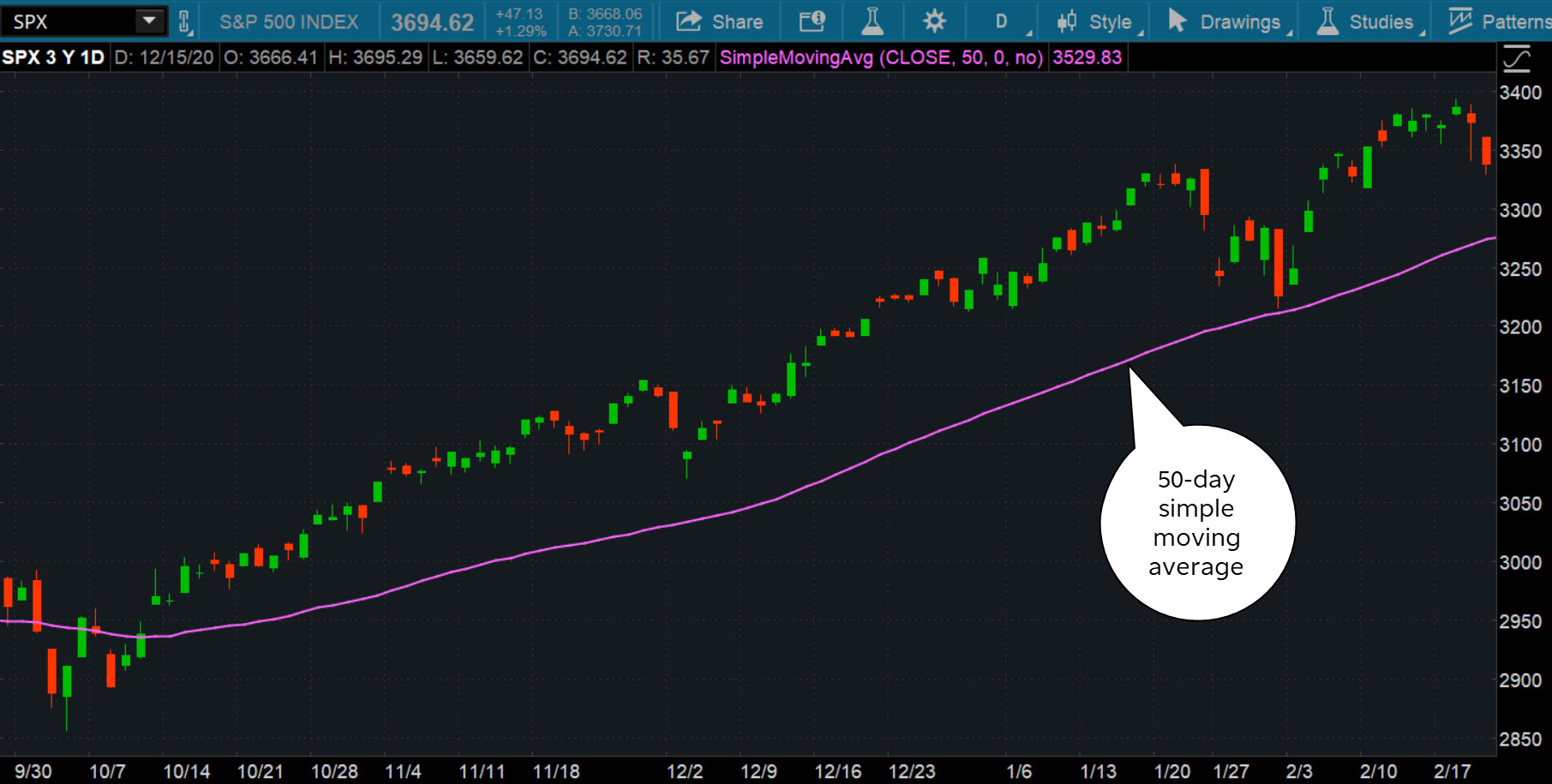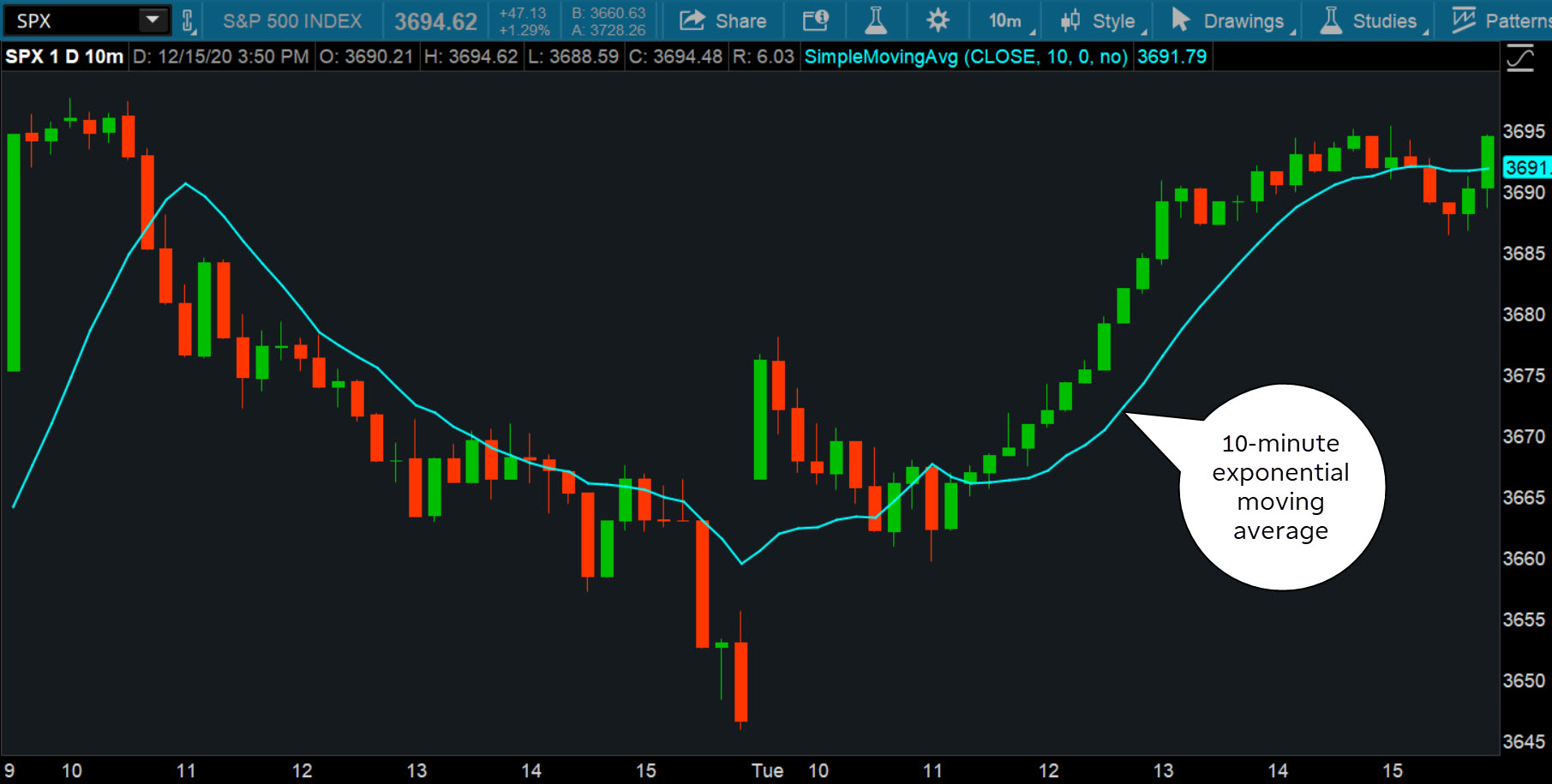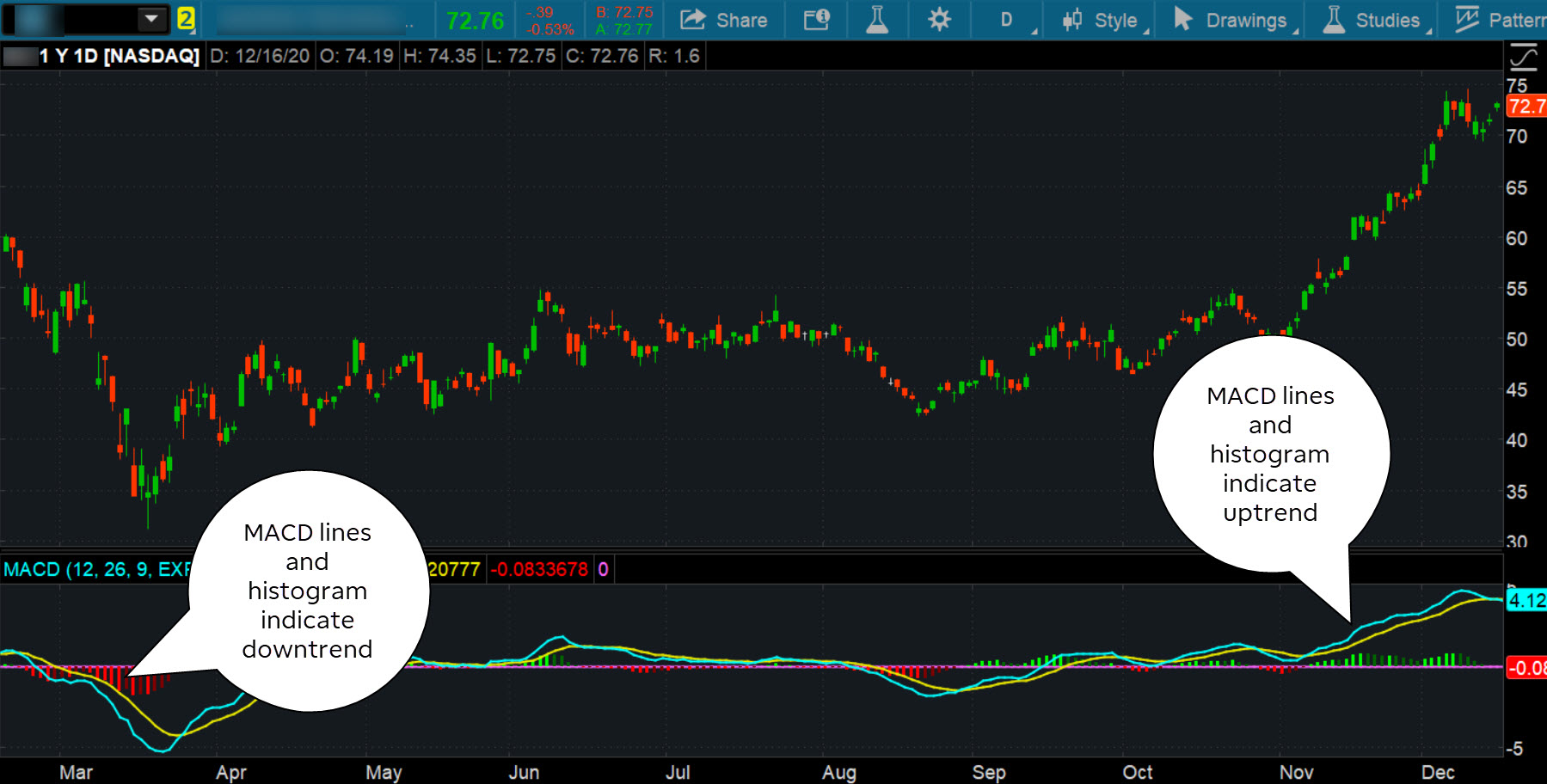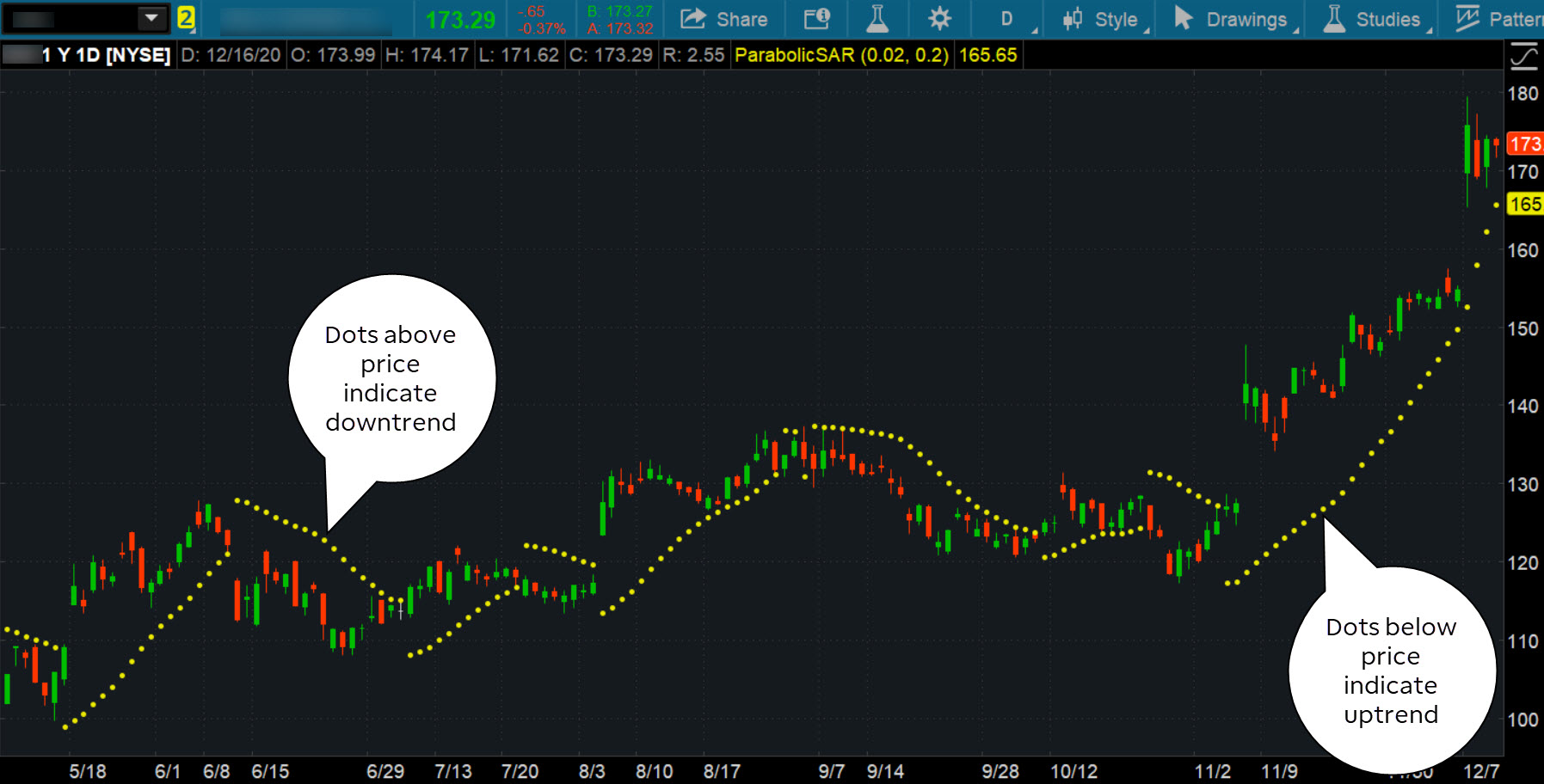How To Set Up Indicators On Thinkorswim
3 Technical Indicators on thinkorswim® to Assistance Find and Follow Trends
How can y'all spot a market place trend? Effort several trend-following technical indicators. 3 of the more than popular ones are moving averages, MACD, and Parabolic SAR.
January 13, 2022

Photo past Getty Images
Fundamental Takeaways
- Three pop trend-following indicators are moving averages, moving average convergence divergence (MACD), and Parabolic SAR
-
Go to know trend-following indicators by experimenting with different ones
- Tendency-following indicators can be used on their ain or combined with other indicators
Many traders, especially those using technical analysis in their trading, often focus on trends. And for good reason: Prices are constantly changing; sometimes very speedily. Traders like to catch these changing prices hoping to ride them out, regardless of whether they're short- or long-lived. Tendency identification is so popular that in that location are many sayings related to trends, such as: Merely how practice yous find the trend in the get-go identify? Pull up a chart of the Dow Jones Industrial Average($DJI) for the last 100 years and information technology'south piece of cake to spot the overriding tendency—upward—but that's non necessarily going to help you trade or manage your portfolio. In that 100-twelvemonth flow, there have been numerous uptrends and downtrends; some lasting years and even decades. Trends occur across all different time frames, and it'south often said the earlier y'all spot a trend, the more opportunity you may have to capitalize on it. Merely that'south easier said than washed. The dainty thing is at that place are many indicators you tin can utilize to identify possible trends, such as linear regression, price envelopes, ADX, and Keltner channels. Three of the more popular ones are moving averages, moving average convergence divergence (MACD), and Parabolic SAR. A moving boilerplate is one of the more popular means to place a trend, only there are different types. And not all moving averages are created equal. Two of the more than common types of moving averages are the simple moving average (SMA) and exponential moving average (EMA). An SMA is calculated by totaling the closing price of a security over a set period and and so dividing that total past the number of time periods. For example, the calculation for a 10-catamenia SMA would exist: The periods used for the calculation could be annihilation from minutes to years. The SMA gives equal weighting to each fourth dimension period, which makes it well suited for identifying longer-term trends. If the security is above the moving average and the moving average is going up, information technology's an indication of an uptrend. If the stock is trading below an uptrending moving average, information technology's withal an uptrend, only it might be weakening. A downtrend occurs when the toll is beneath the moving average and the moving average is pointing downwardly. Calculation indicators to the thinkorswim platform from is a cakewalk. Say you desire to overlay an SMA on a price chart. From the Charts tab, bring up a chart. Select Studies > Add study > Moving Averages. You'll see a pretty extensive list of the different types of moving averages. Select SimpleMovingAvg and you'll meet the SMA plotted on the chart. The default is the nine-flow SMA. To change it, select the indicator, then Edit study SimpleMovingAvg (CLOSE, 9, 0, no) and change the length to 50. This will plot the 50-menstruation SMA on the chart (see figure i).
1. Moving Averages

FIGURE ane: SPX WITH 50-DAY SMA. On this chart of the Southward&P 500 Alphabetize (SPX) with the 50-day SMA overlaid on it (purple), the overall trend looks to be up. If price fell below the moving average, it'd be an indication the index is getting weaker. Chart source: the thinkorswim platform.For illustrative purposes only. Past performance does non guarantee futurity results.
One of the choices under the Moving Averages thinkorswim studies is the EMA, listed as MovAvgExponential. The EMA differs from the SMA in that its calculation assigns more weight to recent prices, making it more responsive to brusk-term price action. Thus, the EMA tends to be favored among many short-term traders. Try calculation the EMA on an intraday chart (see effigy two).

Figure 2: SPX 10-MIN INTRADAY CHART WITH 10-MIN EMA. In this intraday nautical chart of the SPX, you can run into a x-minute EMA (blue). Because the more recent prices have a college weighting, the EMA tends to adapt to price activity quicker than an SMA. Chart source: the thinkorswim platform.For illustrative purposes only. By performance does not guarantee time to come results.
The blazon of moving boilerplate and time periods you might cull will depend on your preferred trading style and fourth dimension horizon, then you might want to experiment with them to meet which is optimal for your purposes. The moving boilerplate convergence difference indicator, or MACD, combines both trend identification and timing into one tool. The MACD belongs to a group of technical indicators chosen oscillators because they tend to movement dorsum and forth from ane side to the other over a period of fourth dimension. The MACD is congenital on the idea that when moving averages begin to diverge from each other, momentum is more often than not thought to be increasing, and a trend may be starting. The creator of the MACD, Gerald Appel, recommends using the settings of 8 and 17 periods to enter a position on the daily chart only suggests a dissimilar combination 12 and 26 flow for selling opportunities. The 9-period MACD average would apply to both. When a 9-period average of the MACD itself is plotted, thereby creating a indicate line. When the indicator line crosses above that signal line, it means an upward trend may exist starting, and when information technology crosses below, it may signal the start of a downtrend. The MACD can too exist plotted equally a histogram. When confined are above the zero line, it indicates an upward tendency, and when the bars are beneath the nil line, it could mean a downtrend. In figure three, the two-line and histogram MACD is plotted in the subchart beneath the price chart.2. Moving Average Convergence Difference (MACD)

Figure 3: APPLYING THE MACD. The MACD indicator is plotted in a subchart below the stock chart as ii lines and a histogram. Every bit the indicator line (blue) crosses above and below the indicate line (yellow) and the histogram confined move above and below the zero line, y'all may be able to identify potential trend changes. Chart source: the thinkorswim platform.For illustrative purposes simply. Past performance does not guarantee hereafter results.
The 12-26-9 configuration is the default setting in thinkorswim, but you can go in and adjust the inputs, depending on your trading preferences. Just select the indicator, then Edit study MACD. In the MACD Customizing window, change the input parameters so select Apply. Some other potential thinkorswim indicator for your trend-finding arsenal, particularly for swing traders, is theParabolic SAR. The "SAR" in Parabolic SAR stands for "finish and reverse," and the indicator is designed so that when a security is in an uptrend, the indicator is plotted beneath the toll in the form of a dot (meet effigy 4). This dot is the theoretical "finish" in the stop and reverse, the signal at which (if the toll touches it) the trend may accept inverse. When this happens, the SAR is then automatically plotted above the price, indicating a downtrend is in event. Some traders use the Parabolic SAR to help them determine where to place terminate orders.3. Parabolic SAR

Effigy 4: USING PARABOLIC SAR TO IDENTIFY TRENDS.The Parabolic SAR, plotted as a yellow dot above or below the daily shut, indicates tendency direction. A series of dots below the price bars indicates an uptrend, whereas a series of dots above the toll bars indicates a downtrend. When the price moves below or higher up these dots, it could indicate a alter in trend direction. Chart source: the thinkorswim platform.For illustrative purposes only. Past functioning does non guarantee future results.
As you can come across from figure 4, the longer the SAR is beneath (or above) the prevailing price, the stronger the trend may be. Yet, on short-term time frames, the Parabolic SAR may be more susceptible to imitation signals (what some traders call "whipsaws").Like all trend-following thinkorswim indicators, the inputs for the Parabolic SAR can be customized and used with whatsoever time frame. These are just a few of the thinkorswim studies you tin choose from when trying to identify and clarify trends in your trading and investing. They can be used equally stand-alone indicators or in conjunction with others. But however you lot wish to use them, make sure y'all take the fourth dimension to familiarize yourself with each to detect the strategy that works all-time for yous.
Key Takeaways
- Three popular tendency-following indicators are moving averages, moving average convergence divergence (MACD), and Parabolic SAR
-
Get to know tendency-following indicators by experimenting with dissimilar ones
- Tendency-post-obit indicators can exist used on their own or combined with other indicators
Start your e-mail subscription
Recommended for y'all
Related Videos
Source: https://tickertape.tdameritrade.com/tools/thinkorswim-trend-indicators-technical-analysis-15565


0 Response to "How To Set Up Indicators On Thinkorswim"
Post a Comment